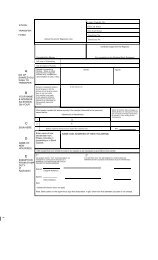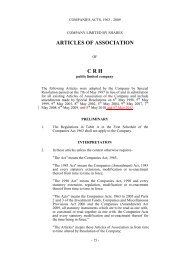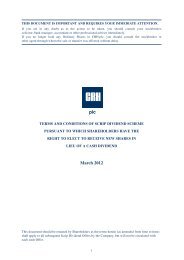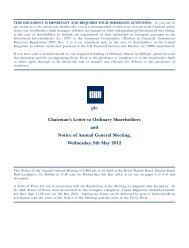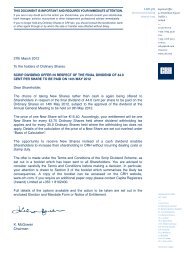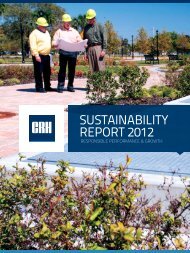2009 Annual Report - CRH
2009 Annual Report - CRH
2009 Annual Report - CRH
- TAGS
- annual
- www.crh.com
Create successful ePaper yourself
Turn your PDF publications into a flip-book with our unique Google optimized e-Paper software.
floating rates (using interest rate swaps), are measured at amortised cost adjusted<br />
for changes in value attributable to the hedged risks arising from changes in<br />
underlying market interest rates. The computation of amortised cost includes any<br />
issue costs and any discount or premium materialising on settlement. Borrowings<br />
are classified as current liabilities unless the Group has an unconditional right to<br />
defer settlement of the liability for at least 12 months after the balance sheet<br />
date.<br />
Gains and losses are recognised in the Consolidated Income Statement through<br />
amortisation on the basis of the period of the loans and borrowings and/or on<br />
impairment and derecognition of the associated loans and borrowings.<br />
Borrowing costs arising on financial instruments are recognised as an expense in<br />
the period in which they are incurred (unless capitalised as part of the cost of<br />
property, plant and equipment).<br />
Provisions for liabilities<br />
A provision is recognised when the Group has a present obligation (either legal or<br />
constructive) as a result of a past event; it is probable that a transfer of economic<br />
benefits will be required to settle the obligation and a reliable estimate can be<br />
made of the amount of the obligation. Where the Group anticipates that a<br />
provision will be reimbursed, the reimbursement is recognised as a separate<br />
asset only when it is virtually certain that the reimbursement will arise. The<br />
expense relating to any provision is presented in the income statement net of any<br />
reimbursement. Provisions are measured at the present value of the expenditures<br />
expected to be required to settle the obligation. The increase in the provision due<br />
to passage of time is recognised as interest expense. Provisions arising on<br />
business combination activity are recognised only to the extent that they would<br />
have qualified for recognition in the financial statements of the acquiree prior to<br />
acquisition. Provisions are not recognised for future operating losses.<br />
Tax (current and deferred)<br />
Current tax represents the expected tax payable (or recoverable) on the taxable<br />
profit for the year using tax rates enacted or substantively enacted at the balance<br />
sheet date and taking into account any adjustments stemming from prior years.<br />
Any interest or penalties arising are included within current tax.<br />
Deferred tax is provided using the liability method on all relevant temporary<br />
differences at the balance sheet date between the tax bases of assets and<br />
liabilities and their carrying amounts for financial reporting purposes. Deferred tax<br />
assets and liabilities are not subject to discounting and are measured at the tax<br />
rates that are anticipated to apply in the period in which the asset is realised or<br />
the liability is settled based on tax rates and tax laws that have been enacted or<br />
substantively enacted at the balance sheet date.<br />
Deferred tax liabilities are recognised for all taxable temporary differences with the<br />
exception of the following:<br />
# where the deferred tax liability arises from the initial recognition of goodwill or<br />
of an asset or a liability in a transaction that is not a business combination and,<br />
at the time of the transaction, affects neither the accounting profit nor the<br />
taxable profit or loss; and<br />
# in respect of taxable temporary differences associated with investments in<br />
subsidiaries, associates and joint ventures, where the timing of reversal of the<br />
temporary differences can be controlled and it is probable that the temporary<br />
differences will not reverse in the foreseeable future.<br />
Deferred tax assets are recognised in respect of all deductible temporary<br />
differences, carry-forward of unused tax credits and unused tax losses, to the<br />
extent that it is probable that taxable profits will be available against which to<br />
offset these items. The following exceptions apply in this instance:<br />
# where the deferred tax asset arises from the initial recognition of an asset or a<br />
liability in a transaction that is not a business combination and affects neither<br />
the accounting profit nor the taxable profit or loss at the time of the transaction;<br />
and<br />
# where, in respect of deductible temporary differences associated with<br />
investments in subsidiaries, joint ventures and associates, a deferred tax asset<br />
is recognised only if it is probable that the deductible temporary difference will<br />
reverse in the foreseeable future and that sufficient taxable profits will be<br />
available against which the temporary difference can be utilised.<br />
The carrying amounts of deferred tax assets are subject to review at each balance<br />
sheet date and are reduced to the extent that future taxable profits are considered<br />
to be inadequate to allow all or part of any deferred tax asset to be utilised.<br />
Where items are accounted for outside of profit or loss, the related income tax is<br />
recognised either in other comprehensive income or directly in equity as<br />
appropriate.<br />
Government grants<br />
Capital grants are recognised at their fair value where there is reasonable<br />
assurance that the grant will be received and all attaching conditions have been<br />
complied with. When the grant relates to an expense item, it is recognised as<br />
income over the periods necessary to match the grant on a systematic basis to<br />
the costs that it is intended to compensate. Where the grant relates to an asset,<br />
the fair value is treated as a deferred credit and is released to the Consolidated<br />
Income Statement over the expected useful life of the relevant asset through<br />
equal annual instalments.<br />
Share capital<br />
Treasury Shares<br />
Own equity instruments (i.e. Ordinary Shares) acquired by the Parent Company<br />
are deducted from equity and presented on the face of the Consolidated Balance<br />
Sheet. No gain or loss is recognised in profit or loss on the purchase, sale, issue<br />
or cancellation of the Parent Company’s Ordinary Shares.<br />
Own shares<br />
Ordinary Shares purchased by the Employee Benefit Trust on behalf of the Parent<br />
Company under the terms of the Performance Share Plan are recorded as a<br />
deduction from equity on the face of the Consolidated Balance Sheet.<br />
Dividends<br />
Dividends on Ordinary Shares are recognised as a liability in the Consolidated<br />
Financial Statements in the period in which they are declared by the Parent<br />
Company.<br />
Emission rights<br />
Emission rights are accounted for such that a liability is recognised only in<br />
circumstances where emission rights have been exceeded from the perspective<br />
of the Group as a whole and the differential between actual and permitted<br />
emissions will have to be remedied through the purchase of the required additional<br />
rights at fair value; assets and liabilities arising in respect of under and overutilisation<br />
of emission credits respectively are accordingly netted against one<br />
another in the preparation of the Consolidated Financial Statements. To the<br />
extent that excess emission rights are disposed of during a financial period, the<br />
profit or loss materialising thereon is recognised immediately within operating<br />
profit in the Consolidated Income Statement.<br />
<strong>CRH</strong> 71








